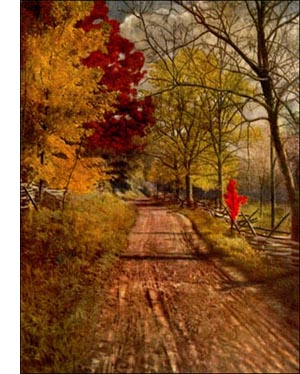Big Shellbark Tree
 Big Shellbark (H. laciniosa, Sarg.)-A tall tree 100 to 120 feet high, with narrow, oblong head. Branches small, spreading. Bark thick, grey, shedding in long thick plates that hang on for years. Twigs orange yellow. Wood heavy, hard, strong, tough, very flexible, dark brown, close grained. Buds terminal, very large, ovate, obtuse; scales silky, outer ones, brown, keeled and pointed; inner ones grow to 3 inches long and 1 inch wide and recurve as leaves appear, turning rosy or yellow on inner, lustrous face; lateral buds small. Leaves 15 to 22 inches long, of 5 to 9 obovate or oblong-lanceolate leaflets, dark green and lustrous above, pale yellow-green or bronzy pubescent below; petioles stout, enlarged at base, recurved and persistent during winter. Flowers: staminate in catkins 5 to 8 inches long, smooth, or rufous pubescent ; pistillate in spikes, terminal, 2 to 5-flowered, pale tomentose, angled, green. Fruit solitary or paired, in woody, 4-valved husk, sutures opening half way at maturity, downy, orange brown, 1 3/4 to 2 1/2 inches long; nut compressed, with 4 to 6 ridges, 1 1/4 to 2 1/4 inches long; hard, bony, thick, enclosing sweet, fine-flavoured kernel. Preferred habitat, rich, deep bottom lands. Distribution, Iowa, Missouri and Arkansas, eastern Kansas and Oklahoma; Illinois and Indiana to Tennessee, New York and Pennsylvania. Uses: Nuts commercially valuable. Wood not distinguished from that of H. ovata. A worthy ornamental tree.
Big Shellbark (H. laciniosa, Sarg.)-A tall tree 100 to 120 feet high, with narrow, oblong head. Branches small, spreading. Bark thick, grey, shedding in long thick plates that hang on for years. Twigs orange yellow. Wood heavy, hard, strong, tough, very flexible, dark brown, close grained. Buds terminal, very large, ovate, obtuse; scales silky, outer ones, brown, keeled and pointed; inner ones grow to 3 inches long and 1 inch wide and recurve as leaves appear, turning rosy or yellow on inner, lustrous face; lateral buds small. Leaves 15 to 22 inches long, of 5 to 9 obovate or oblong-lanceolate leaflets, dark green and lustrous above, pale yellow-green or bronzy pubescent below; petioles stout, enlarged at base, recurved and persistent during winter. Flowers: staminate in catkins 5 to 8 inches long, smooth, or rufous pubescent ; pistillate in spikes, terminal, 2 to 5-flowered, pale tomentose, angled, green. Fruit solitary or paired, in woody, 4-valved husk, sutures opening half way at maturity, downy, orange brown, 1 3/4 to 2 1/2 inches long; nut compressed, with 4 to 6 ridges, 1 1/4 to 2 1/4 inches long; hard, bony, thick, enclosing sweet, fine-flavoured kernel. Preferred habitat, rich, deep bottom lands. Distribution, Iowa, Missouri and Arkansas, eastern Kansas and Oklahoma; Illinois and Indiana to Tennessee, New York and Pennsylvania. Uses: Nuts commercially valuable. Wood not distinguished from that of H. ovata. A worthy ornamental tree.In the markets we often see nuts of large size-more flattened than English walnuts and fully as large-which the dealer calls "shellbarks." They look like a larger form of the little shellbarks; but we hesitate. They are strangers, and their flavour is an unknown quantity. These are the "king nuts"-not equal to the little shellbarks in quality, yet sweet, edible nuts, though in thick shells. They are distributed from the cities along the Mississippi, and are appearing in increasing quantities in Eastern markets.
In winter the tree may be recognised by its dead petioles, curving back on the twigs which bore leaves the past summer. The very large terminal buds are another winter trait. At any season the orange-coloured twigs are the best distinguishing feature of the species. This tree has shaggy bark, though this character is less pronounced than in H. ovata. It is hardy in the Arnold Arboretum, near Boston, and seems to grow more rapidly than other hickories in cultivation. in the wild it grows in bottom lands, but does well on dryer, sloping ground.
A hybrid between the pecan and laciniosa is reported by Dr. Trelease, and named for its discoverer the "Nussbaumer Hybrid." It is not especially promising.